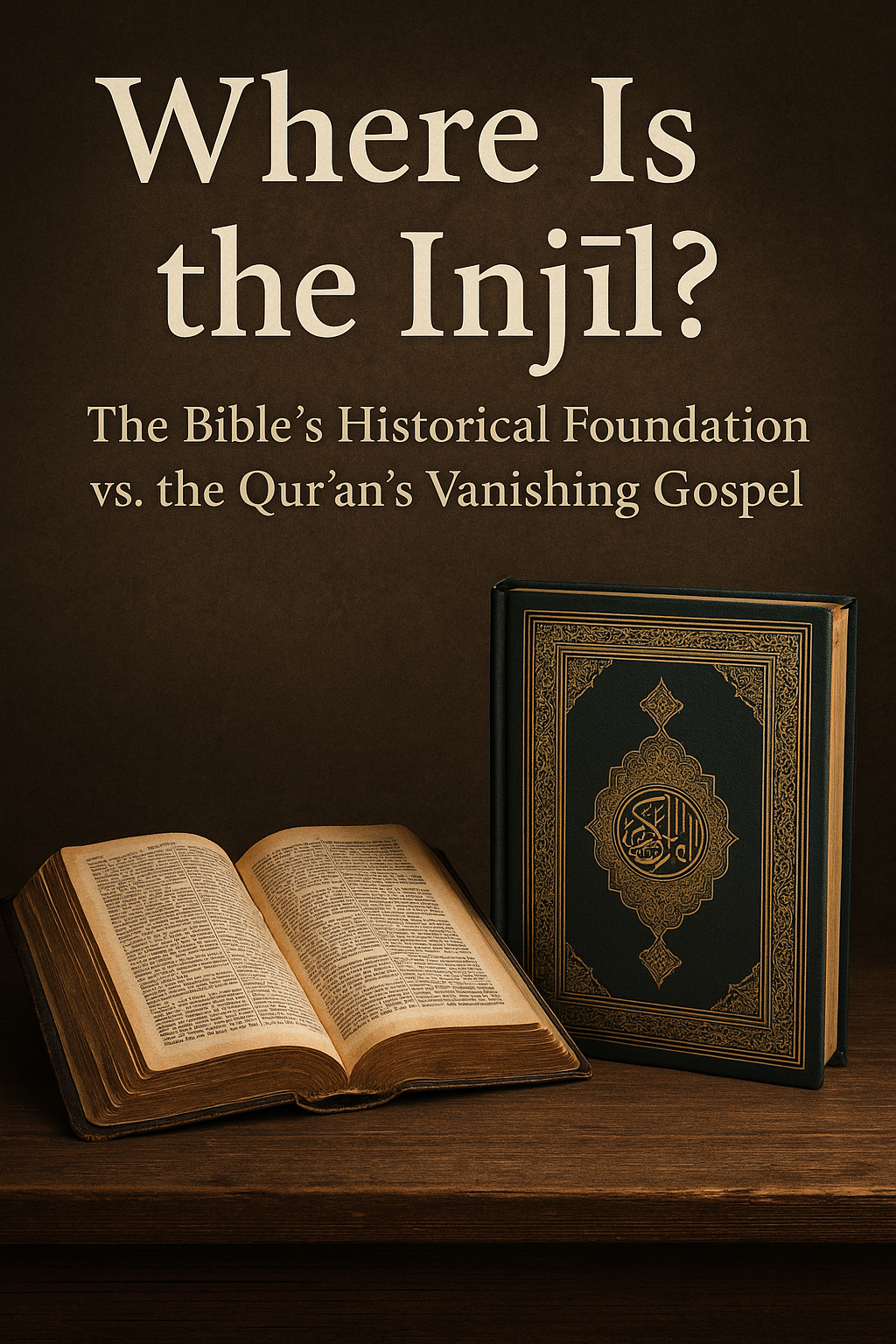

By Dr. Tim Orr
One of the most striking claims in the Qur’an is that Jesus, known in Arabic as ʻĪsā, was given a divinely revealed book called the Injīl. This idea appears multiple times in the Qur’an, including in Surah 5:46, which states that God gave Jesus the Injīl, following the Torah given to Moses. For Muslims, this book is not a minor reference or symbolic gesture; it is one of the heavenly scriptures that believers must affirm, along with the Torah, the Psalms (Zabur), and the Qur’an. Yet we find a deafening silence when we turn to textual, archaeological, and literary history. No manuscripts, fragments, or references in early Christian writings—canonical or otherwise—suggest that Jesus received a divinely revealed book. If such a book had existed, we would expect to find at least some trace of it: citations from the Church Fathers, debates in early church councils, or mentions in heretical texts. Instead, the historical record is completely blank. There is no trace of a revealed book ever being given to Jesus. Not only does it not appear in Christian history, but it is also absent from apocryphal literature, patristic writings, and early church disputes. Even heretical Christian sects never made such a claim. The Injīl, as described in the Qur’an, is not just missing—it’s invisible.
This raises a deeply important question. If a central claim of the Qur’an lacks historical support, what does that suggest about its reliability? More specifically, why is there an overwhelming amount of evidence for the Bible, particularly the New Testament, and no evidence at all for the existence of the Injīl?
The Qur’an’s Assertion: A Book Given to Jesus?
According to Gabriel Said Reynolds, a professor of Islamic Studies at the University of Notre Dame, all twelve occurrences of the word Injīl in the Qur’an present it as a distinct book or revelation given directly to Jesus. This model mimics how the Torah was given to Moses and how the Qur’an was revealed to Muhammad (Reynolds, 2020). The Qur’an even instructs Christians to judge by what God has revealed in the Injīl (Qur’an 5:47), which strongly implies that the book was not only real but accessible at the time of Muhammad.
However, Reynolds notes that this claim is historically implausible. “We do not find this idea that Jesus himself wrote a gospel and sought to disseminate it… It’s just not there,” he explains (Capturing Christianity, 2024, 36:40). There is no evidence—not from the canonical gospels, not from early Church Fathers, not even from Gnostic or apocryphal sources—that Jesus received a divinely dictated scripture. The earliest followers of Jesus proclaimed his life, death, and resurrection, not a book he wrote or received. Christian tradition consistently holds that Jesus was the Word made flesh (John 1:14), not the bearer of a physical book. The message of Jesus was embodied in his person, not encoded in a scroll.
How Muslim Scholars Have Tried to Explain the Absence
In light of this historical silence, Muslim scholars have developed several theories to reconcile the Qur’anic claim with the complete lack of evidence. Reynolds outlines a handful of common responses. First, some argue that early Christians lost or corrupted the original Injīl. According to this view, the teachings of Jesus were distorted over time, and the current New Testament is a flawed remnant. Others suggest that only fragments of the true Injīl survive—usually those parts of the New Testament that align with the Qur’an. For example, some Muslims accept the so-called “red-letter” words of Jesus while rejecting the theological framework surrounding them.
A more academically nuanced theory is that the Injīl may correspond to the hypothetical Q source—a reconstructed sayings collection that scholars believe underlies the Gospels of Matthew and Luke. Still others propose that the Injīl is a celestial book known only to God, abstract and inaccessible in human history. The most creative, though least credible, suggestion comes from those who cite the Gospel of Barnabas, a document that contains numerous anachronisms, including references to medieval European feudal structures, and a theological narrative that aligns more with Islamic doctrine than any known early Christian teaching. This 16th-century document portrays Jesus as a proto-Muslim figure who foretells the coming of Muhammad. However, mainstream scholars—Muslim and Christian alike—recognize this text as a late forgery, possibly produced by a Muslim convert (Gilchrist, 1993).
Despite these attempts, no explanations are supported by manuscript evidence, citations in early Christian writings, or historical documentation. They remain theological assertions, not historical conclusions. As Reynolds puts it, these responses reflect Islam’s attempt to affirm continuity with earlier revelation while retroactively fitting Jesus into a theological mold that centers around Muhammad (Capturing Christianity, 2024).
The New Testament: A Contrast in Clarity and Evidence
While the Injīl remains entirely unattested in history, the New Testament is the best-preserved body of literature from the ancient world. Its documentation is not merely adequate—it’s overwhelming. There are over 5,800 Greek manuscripts of the New Testament and thousands more in Latin, Syriac, Coptic, and other languages. Some of these fragments date to the early second century. The earliest undisputed fragment, P52, contains a portion of John’s Gospel and is commonly dated around 125 A.D., within a generation of the original composition (Wallace, 2012).
However, manuscript evidence is only part of the story. The early Church Fathers—figures like Ignatius, Polycarp, Justin Martyr, and Irenaeus—quoted the New Testament so extensively that virtually the entire text could be reconstructed from their citations alone (Metzger & Ehrman, 2005). Additionally, we have early creedal statements, such as 1 Corinthians 15:3–7, which most scholars agree predate Paul’s writings and can be dated to within a few years of Jesus’ crucifixion. This creed describes Jesus’ death, burial, resurrection, and post-resurrection appearances—not abstract doctrines, but historical claims rooted in eyewitness testimony (Habermas, 2006).
In contrast to the elusive Injīl, the Bible was written in known places (Jerusalem, Antioch, Ephesus, Rome), by known authors (apostles or their companions), and in a known language (Greek). It was publicly proclaimed, rapidly copied, and widely distributed across the Roman Empire.
A Theological Placeholder, Not a Historical Reality
Reynolds suggests that the Qur’an’s description of the Injīl serves a theological purpose rather than a historical one. The Qur’an uses earlier prophets, including Jesus, to foreshadow Muhammad. For instance, in Surah 61:6, Jesus is depicted as saying, “O Children of Israel, indeed I am the messenger of Allah to you confirming what came before me of the Torah and bringing good tidings of a messenger to come after me, whose name is Ahmad.” This verse positions Jesus not only as affirming previous revelation but as explicitly anticipating Muhammad’s arrival, reinforcing the Qur’an’s pattern of using previous prophets to validate its final message. In this narrative, every prior prophet faces rejection, affirms monotheism, and anticipates the coming of a final messenger. Reynolds explains, “The Qur’an retroactively inserts Jesus into its theological framework to bolster Muhammad’s prophetic status, not to accurately portray Christian origins” (Capturing Christianity, 2024, 45:02). Thus, the Injīl functions as a symbolic confirmation of Muhammad’s message—not a record of Jesus’ life or teachings.
This interpretation explains why the Qur’an contains so little content attributed to Jesus. His parables, teachings, and death and resurrection are conspicuously absent. Even basic details—like the names of the disciples or the locations of his ministry—are left out. What the Qur’an does preserve are vague affirmations and polemical denials—particularly a rejection of the crucifixion and divinity of Christ. In other words, the Qur’an engages with a caricature of Christianity rather than its substance.
Preservation, Corruption, and Double Standards
Muslims often argue that the Qur’an has been perfectly preserved, citing Surah 15:9, which states, “Indeed, it is We who sent down the Qur’an and indeed, We will be its guardian.” While this claim carries enormous theological weight, the historical record tells a more complex story. Early Islamic sources report variant codices of the Qur’an—most notably those of Ibn Masʿud and Ubayy ibn Kaʿb. Caliph Uthman famously ordered a standardized version and commanded that all other versions be destroyed (Reynolds, 2020). While modern Muslims see this as divinely guided preservation, others see it as a political consolidation with historical implications.
Meanwhile, the New Testament has never been forcibly standardized. Variants exist—because the process was transparent and decentralized—but they are documented in critical editions, such as the Nestle-Aland Greek New Testament. These include minor spelling differences, word order changes, and occasional insertions or omissions of short phrases. For example, some manuscripts of Mark 1:1 read "Jesus Christ, the Son of God," while others omit "the Son of God," like the Nestle-Aland Greek New Testament. Most importantly, no essential Christian doctrine is questioned due to textual variation. The historical integrity of the New Testament rests not on theological assertion but on massive manuscript evidence and the academic discipline of textual criticism.
Why It Matters
The question of the Injīl is not a footnote—it is foundational. If the Qur’an claims that Jesus was given a divine book, and no such book ever existed, then we are forced to question the reliability of the Qur’an itself. This potentially undermines more than one passage—it calls into question the Qur’an’s self-proclaimed continuity with Jewish and Christian revelation. If it reimagines the past to authenticate its message, then we must ask: Is it truly a continuation of divine revelation, or a theological retrofit?
By contrast, Christianity invites investigation. The gospel is not a private revelation but a public proclamation. It is rooted in real events, witnessed by real people, and preserved in real documents. That’s why there is overwhelming evidence for the Bible—and no evidence for the Injīl.
References
Capturing Christianity. (2024). Gabriel Said Reynolds: The Quran vs. the Gospel – Full Interview [Video]. YouTube. https://www.youtube.com/watch?v=[placeholder]
Gilchrist, J. (1993). The Gospel of Barnabas: An Islamic Forgery. Jesus to Muslims.
Habermas, G. (2006). The Historical Jesus: Ancient Evidence for the Life of Christ. College Press.
Metzger, B. M., & Ehrman, B. D. (2005). The Text of the New Testament: Its Transmission, Corruption, and Restoration (4th ed.). Oxford University Press.
Reynolds, G. S. (2020). The Qur’an and the Bible: Text and Commentary. Yale University Press.
Wallace, D. B. (2012). Revisiting the Corruption of the New Testament: Manuscript, Patristic, and Apocryphal Evidence. Kregel Academic.
Who is Dr. Tim Orr?
Tim serves full-time with Crescent Project as the assistant director of the internship program and area coordinator, where he is also deeply involved in outreach across the UK. A scholar of Islam, Evangelical minister, conference speaker, and interfaith consultant, Tim brings over 30 years of experience in cross-cultural ministry. He holds six academic degrees, including a Doctor of Ministry from Liberty University and a Master’s in Islamic Studies from the Islamic College in London.
In addition to his ministry work, Tim is a research associate with the Congregations and Polarization Project at the Center for the Study of Religion and American Culture at Indiana University Indianapolis. His research interests include Islamic antisemitism, American Evangelicalism, and Islamic feminism. He has spoken at leading universities and mosques throughout the UK—including Oxford University, Imperial College London, and the University of Tehran—and has published widely in peer-reviewed Islamic academic journals. Tim is also the author of four books.
